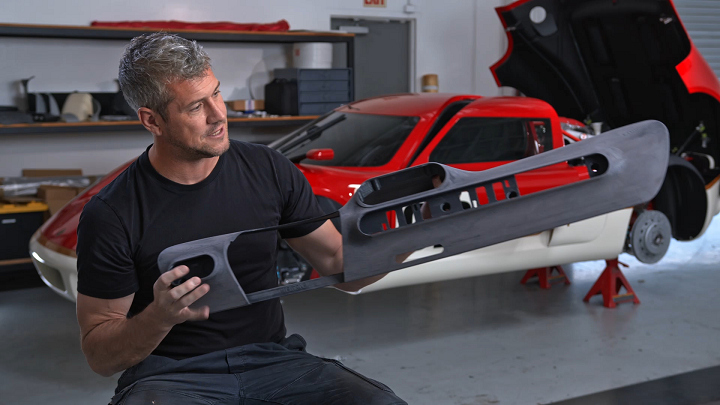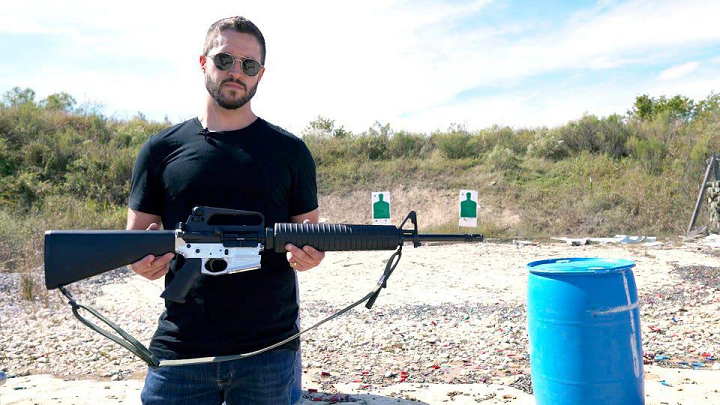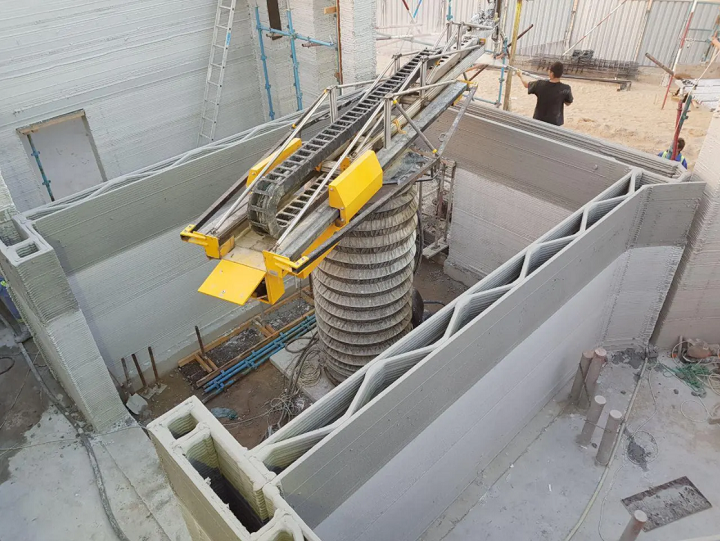In today’s 3D Printing News Briefs, a Volkswagen subsidiary has invested in an SLM Solutions 3D printer, and Stratasys partnered with Radford to 3D print sports car parts. Then we move on to 3D printed heat exchangers and MagLev switches, and Apis Cor has a new mobile house 3D printing robot. Finally, Cody Wilson says sales of his 3D printed ghost guns are up, as President Biden vows to slow the market for the weapons.
MAN Energy Solutions Places Order for NXG XII 600
First up, SLM Solutions Group AG announced that it received an order from Volkswagen Group subsidiary MAN Energy Solutions for its powerful 12-laser NXG XII 600 3D printer. MAN ES has been using an SLM 280 PS since 2019, but needed a larger envelope to meet demand for large-scale 3D printed parts, and the NXG Xll 600, with its 600 x 600 mm² area, certainly fits the bill. The 12-laser system meets the needs for stressed, robust applications that require strict mechanical properties, which makes it a good choice for the energy sector, which, according to AMPOWER, is expected to triple its total value of system sales by 2025 past €150 million in value. The NXG XII 600 will be used for serial production of components in the energy, industrial, and marine sectors, and will be installed at MAN Energy Solutions’ Additive Manufacturing Center in Oberhausen, Germany.
“We are pleased to continue our successful cooperation with SLM Solutions,” said Anders Such, Head of Additive Manufacturing at MAN Energy Solutions. “The NXG Xll 600 represents the next step for the industrialization of additive manufacturing at MAN Energy Solutions. On the one hand, this machine enables us to manufacture large components using economically competitive AM technology. On the other hand, it helps to make the existing AM business cases even more attractive. This perfectly aligns with our company target to further develop innovative production technologies.”
Stratasys & Radford 3D Printing 500+ Parts for Lotus Type 62-2

Host Ant Anstead shows a 3D printed part for the Lotus Type 62-2 coachbuilt as shown in the Discovery+ documentary, Radford Returns
Stratasys (NASDAQ: SSYS) announced a partnership with global luxury automotive brand Radford to produce over 500 3D printed parts for the Lotus Type 62-2 coachbuilt sports car, the launch of which is shown in the Discovery+ documentary Radford Returns. The show documents the build of what Stratasys called the “retro-modern” supercar, and viewers get to see the whole process for the parts, from design and prototyping to tooling and 3D printing them using FDM, SLA, and PolyJet technologies. More than 500 parts for the first two cars were 3D printed at the Radford Studio, automotive design and engineering firm Aria Group, and Stratasys Direct Manufacturing, and the GrabCAD Shop workflow management software was used to schedule and track the prints on a fleet of up to 20 Stratasys printers—including the J55, F770, and Fortus 450mc—across five global locations. Some of the 3D printed parts include mounting brackets, radiator ducts, and side mirror housings.
“By integrating 3D printing technology into their shop, Radford has been able to bring 1960’s-style supercar automaking into the 21st century with the high-end, hyper-customized style and features that their customers expect in a vehicle of this caliber. It’s an extreme example of something we see every day in the auto industry. Everyone making investments in new vehicles wants a deeper level of customization and 3D printing is helping make it possible,” said Pat Carey, Senior Vice President, Strategic Growth for Stratasys.
3D Printing Heat Exchangers in AddUp 3DCALOR Project
In a new consortium, IRT Jules Verne, together with partners Fives, AddUp, and the CNRS – National Center for Scientific Research/LTEN (Laboratory of Thermics and Energy of Nantes), have launched the year-long 3DCALOR project for the purposes of 3D printing heat exchangers. The goal of this project is to investigate new geometries for heat exchangers that are possible with 3D printing, as well as determine the major technological barriers to 3D printing heat exchangers and evaluate the performance of integrating new architectures inspired by biomimetic principles.
“The project will also include work on the functionalization of surfaces by texturing and on the development of a product/process design and optimization strategy,” IRT Jules Verne wrote on its website.
“At the end of these 12 months, it could lead to a second, larger project in which the topological optimisation aspects and the implementation of a methodology for industrial development would be further developed.”
Hackaday Project: 3D Printed MagLev Switches
Moving on, Hackaday posted an interesting project about “bespoke input devices”—3D printed magnetic levitation, or MagLev, switches, to be exact. GitHub user famichu developed the design for the open source magnetic MX-style switch, which Hackaday calls “markedly different from what we’ve seen previously,” namely the void_switch from riskable. famichu wanted their magnetic switch to operate similarly to how a traditional Cherry MX switch does, which is why each one, with its own sensor, is pinned, and they have to be wired together to form a matrix, instead of putting sensors on the main PCB so electrical connections don’t need to be made to each switch. It’s recommended to print the parts for the MagLev Switch MX on an SLA or DLP system, and famichu included the Fusion 360 design files, as well as STL/3MF models.
“Internally, [famichu] has come up with a unique arrangement wherein the Allegro A1304 linear Hall effect sensor is actually placed in between two opposing magnets that stand in for the traditional spring. When the key is depressed the sensor will pick up the magnetic flux environment changing around it, but interestingly, the schematic for the keyboard PCB would seem to indicate that the senors are not being read directly by the microcontroller. Instead, their output is being used to trigger MOSFETs on each row of the matrix.”
Mobile House 3D Printing Robot by Apis Cor
Florida-based Apis Cor develops robots that 3D print buildings, and recently introduced a mobile robot 3D printing system for this purpose, which will help the company scale up its technology. This robotic 3D construction printer is said to have a unique design that allows for easy transport with a pickup truck and trailer, and only takes two people to set up and operate, thus allowing for a structure to be built onsite without extra assembly. That’s the company’s ultimate goal—automating the construction industry, and transitioning to cement-free materials, to truly make an impact. Apis Cor is already taking $7,000 reservations for its mobile 3D robotic printer in the US, and plans to start work on these projects in 2023, after which it will expand to other countries.
“3D printing technology allows us to reduce the amount of construction waste,” said Anna Chen-iun-tai, CEO and Co-Founder of Apis Cor. “Additive manufacturing is the opposite to the subtractive manufacturing process where you need to cut out extra material to build a needed shape. In the case of 3D printing, you add as much material as you need to create a shape.”
Cody Wilson Not Worried about 3D Printed Gun Crackdown

Cody Wilson at a firing range near Austin, Texas, displays his “zero percenter” firearm. Image courtesy of Forbes
Finally, ever since we first heard about the Defense Distributed “Liberator” pistol by Cody Wilson nearly ten years ago, the debate on 3D printed guns has continued. Recently, President Joe Biden announced that he would work to slow the expanding market for ghost guns, but Wilson, who invented these untraceable weapons, isn’t worried, saying that he’s selling his $2,500 Ghost Gunner 3 kits like hotcakes, noting sales of up to 55 a week. And the numbers seem to back up his claim—according to the US Bureau of Alcohol, Tobacco, and Firearms, the number of suspected ghost guns reported annually by state and local law enforcement has jumped from 1,750 to 8,712.
But last month, the president promised to use federal backup against ghost guns, and wants to improve the definition of a firearm so it includes the words “weapon parts kit that is designed to or may readily be assembled, completed, converted or restored to expel a projectile by the action of an explosive.” A whitepaper from the Justice Department outlines a new strategy that would include an ATF “ghost-gun coordinator” in every field division, and according to Christian Heyne, Vice President of Policy at gun-control nonprofit Brady United, the ATF is close to finalizing this new rule. Legal experts say that this plan could finally be what stops Wilson in his tracks.
Subscribe to Our Email Newsletter
Stay up-to-date on all the latest news from the 3D printing industry and receive information and offers from third party vendors.
Print Services
Upload your 3D Models and get them printed quickly and efficiently.
You May Also Like
IperionX Gets $12.5 Million from the DoD to Ramp Up U.S. Titanium Production
Titanium technology company IperionX (ASX: IPX) has received $12.5 million from the U.S. Department of Defense (DoD) to boost titanium production at its Virginia manufacturing campus. This money is part...
Arun Jeldi’s American Dream: the Velo3D CEO on Where the Company, and Metal 3D Printing, are Headed
“I have a plan for 2050,” Dr. Arun Jeldi told me, “for how Velo3D can keep growing through that time, and longer. I want Velo3D to be a century-old company...
RAF Fits First 3D Printed Component to Operational Typhoon Fighter
The Royal Air Force (RAF) has successfully fitted its first in-house 3D printed component to an operational Typhoon fighter jet. The move is a major step toward faster military aircraft...
3D Printing Financials: 3D Systems Turns Profit Amid Revenue Decline
3D Systems (NYSE: DDD) has reported its financial results for the second quarter of 2025, showing a drop in revenue but a sharp improvement in profitability, driven by cost reductions,...


































